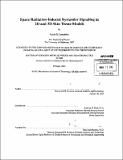Space radiation-induced bystander signaling in 2D and 3D skin tissue models
Author(s)
Lumpkins, Sarah B
DownloadFull printable version (13.28Mb)
Other Contributors
Harvard--MIT Program in Health Sciences and Technology.
Advisor
Kathryn D. Held.
Terms of use
Metadata
Show full item recordAbstract
Space radiation poses a significant hazard to astronauts on long-duration missions, and the low fluences of charged particles characteristic of this field suggest that bystander effects, the phenomenon in which a greater number of cells exhibit damage than expected based on the number of cells traversed by radiation, could be significant contributors to overall cell damage. The purpose of this thesis was to investigate bystander effects due to signaling between different cell types cultured within 2D and 3D tissue architectures. 2D bystander signaling was investigated using a transwell insert system in which normal human fibroblasts (A) and keratinocytes (K) were irradiated with 1 GeV/n protons or iron ions at the NASA Space Radiation Laboratory using doses from either 2 Gy (protons) or 1 Gy (iron ions) down to spacerelevant low fluences. Medium-mediated bystander responses were investigated using three cell signaling combinations. Bystander signaling was also investigated in a 3D model by developing tissue constructs consisting of fibroblasts embedded in a collagen matrix with a keratinocyte epidermal layer. Bystander experiments were conducted by splitting each construct in half and exposing half to radiation then placing the other half in direct contact with the irradiated tissue on a transwell insert. Cell damage was evaluated primarily as formation of foci of the DNA repair-related protein 53BP1. In the 2D system, both protons and iron ions yielded a strong dose dependence for the induction of 53BP1 in irradiated cells, while the magnitudes and time courses of bystander responses were dependent on radiation quality. Furthermore, bystander effects were present in all three cell signaling combinations even at the low proton particle fluences used, suggesting the potential importance of including these effects in cancer risk models for low-dose space radiation exposures. Cells cultured in the 3D constructs exhibited a significant reduction in the percentages of both direct and bystander cells positive for 53BP1 foci, although the qualitative kinetics of DNA damage and repair were similar to those observed in 2D. These results provide evidence that the microenvironment significantly influences intercellular signaling and that cells may be more radioresistant in 3D compared to 2D systems.
Description
Thesis (Sc. D.)--Harvard-MIT Program in Health Sciences and Technology, 2012. Page 157 blank. Cataloged from PDF version of thesis. Includes bibliographical references (p. 145-156).
Date issued
2012Department
Harvard University--MIT Division of Health Sciences and TechnologyPublisher
Massachusetts Institute of Technology
Keywords
Harvard--MIT Program in Health Sciences and Technology.